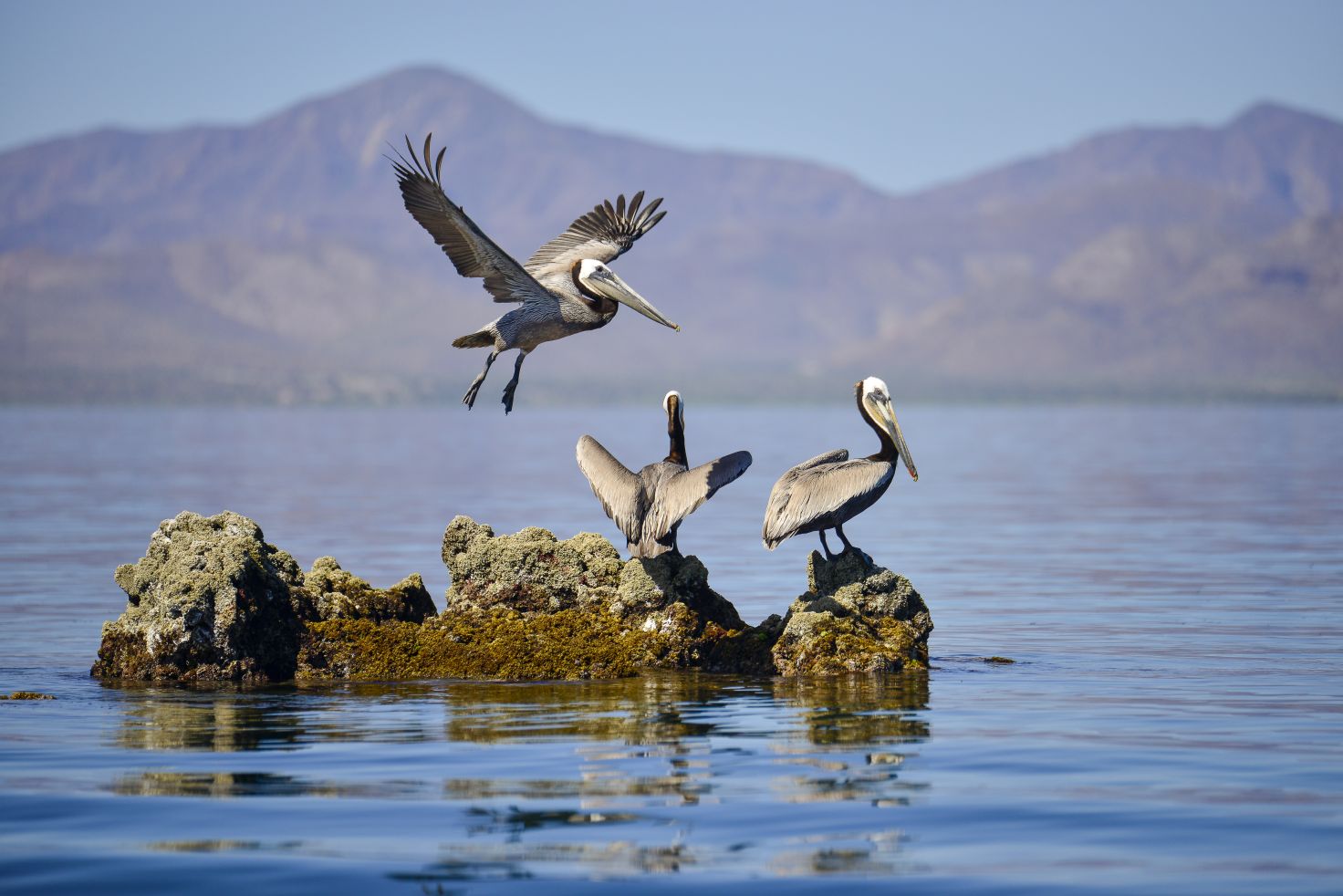Set sail on a journey of discovery with Lindblad Expeditions-National Geographic on Mexico’s Sea of Cortez, home to some of the greatest biodiversity in the Pacific.
It’s often when you least expect it that the most amazing travel experiences take place. As we skim across the mirror-like waters of the Sea of Cortez, basking under a blazing mid-day sun, the air laced with salt and the warm rubber of the zodiac, most of my fellow guests are thinking more about lunch than wildlife.
READ: We Ride the Snake in the Peruvian Amazon
That is until a grey whale calf decides to put on an impromptu performance, leaving its mother’s side for a moment and leaping out of the water like an SUV-sized rocket, the golden sunshine shimmering off its flanks as it collapses back into the water. We’re half expecting to hear a child-like giggle over the drone of camera mechanisms and the chug of the outboard as the waters still once again.
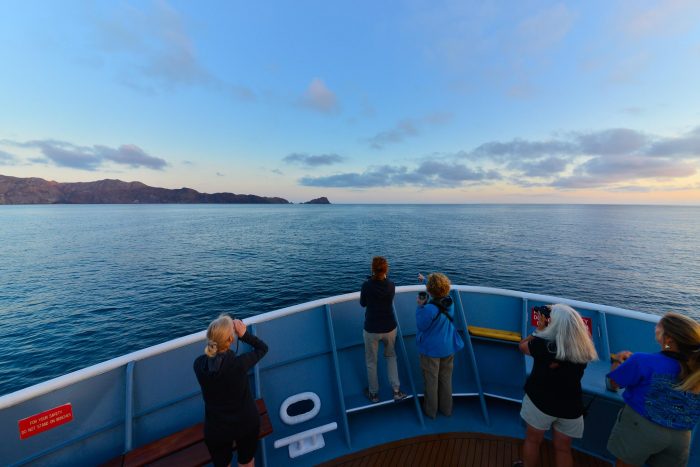
It’s the latest in a series of magnificent up-close-and-personal encounters with the residents of Mexico’s hidden gem. The Sea of Cortez, a finger of water nestled between the Mexican mainland and the Baja Peninsula, is the kind of place where one should expect the unexpected. With a dizzying array of marine life and a multitude of fragile, interconnected ecosystems, the Sea of Cortez has enchanted navigators, explorers, and naturalists for centuries. Fed by great rivers like the Colorado, the Sinaloa, the Sonora, and the Yaqui, the Sea of Cortez is one of the most diverse seas on the planet, with over 900 fish species, fevers of graceful manta and devil rays, and colonies of grinning sea lions. It’s quite possibly the most amazing place you’ve never heard of.
READ: Ensure You Start Your Sea of Cortez Adventure at This Spectacular Resort
Despite its proximity to major cities like Los Angeles, most people who travel to Baja and the Sea of Cortex rarely venture from the luxurious resorts of Cabo San Lucas, in the far south; if they do it’s on day tours searching for the grey whales which winter in the nutrient-rich waters. But to really experience the Sea of Cortez, which famed French marine explorer Jacques Cousteau dubbed ‘the aquarium of the world’, you need to really leave the Peninsula in your wake.
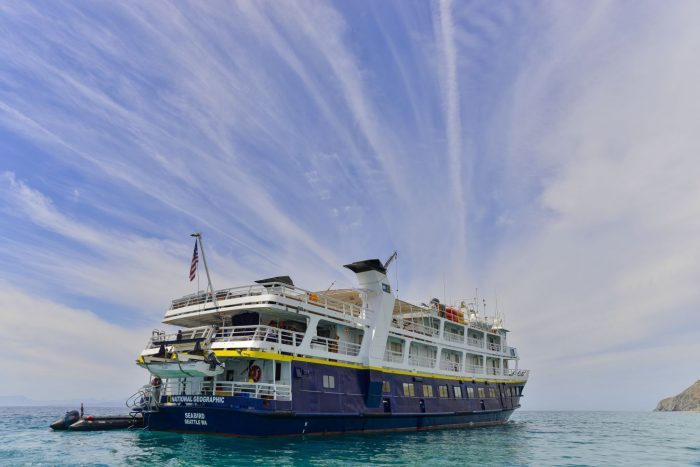
I’ve done exactly that, setting sail aboard the National Geographic Sea Bird, a ferry-turned-expedition ship operated in a partnership between Lindblad Expeditions, one of the world’s oldest expedition companies, which has been plying the waters of the Sea of Cortez, also known as the Gulf of California, since 1977, and the famed natural sciences magazine. The Sea Bird is the ideal vessel for exploring this remarkable destination; with a shallow draft, a flotilla of kayaks, a complement of guides and naturalists, and room for just 62 guests in 31 outside cabins, the sturdy little vessel allows a uniquely intimate encounter with this mesmerizing landscape of deep waters and desert islands.
READ: The Galapagos Islands is the Land Before Time
As the sun hangs low in the sky, we depart from the town of La Paz, the sound of Merengue reaching out across the water from the bars that line the beach. I join my fellow guests, most of whom are from the US, at the ship’s bow as we watch the sun slip behind a mountain range, the resulting darkness quickly replaced by a plethora of stars.
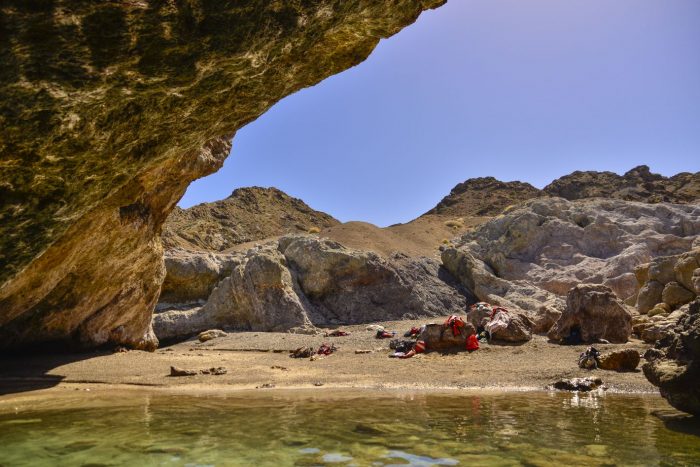
The action begins with dawn the next morning when expedition leader Larry Prussin rouses us from sleep in time to watch a 700-strong pod of common dolphins surrounds the ship. The dolphins ride the bow wave, leaping and surfing on the ship’s wake, completely in their element, as guests line the rails, cameras at the ready. As the pod moves away, a pair of blue whales surfaces nearby; the Sea of Cortex is home to the greatest variety of whales and dolphins in the world – over 30 species – and the blue whales, the largest animals on the planet, depart their feeding grounds in the eastern Pacific and explore the Sea’s nutrient-rich waters for a few weeks each year. The tiny dorsal fins of the whales belie their magnitude; blue whales can grow to 30 meters in length and weigh as much as a commercial jetliner. We trail slowly after them, the spray from their spouts lingering in the early morning sunshine like gold dust.
READ: Get Wild At This Cambodian Tented Camp
The Sea of Cortez is a truly unique marine environment, but it’s also one under threat. The whales and dolphins draw thousands of visitors to the Baja coastline each year, and tourism, combined with fishing and increased industrialization, has put immense pressure on the Gulf of California and its marine life. Some of the Sea’s most iconic residents have been brought to the brink of extinction, including hammerhead sharks, the endemic totoaba fish, prized in traditional Chinese medicine, and the vaquita, the world’s most critically endangered marine mammal, whose numbers have been decimated by illegal gill nets.
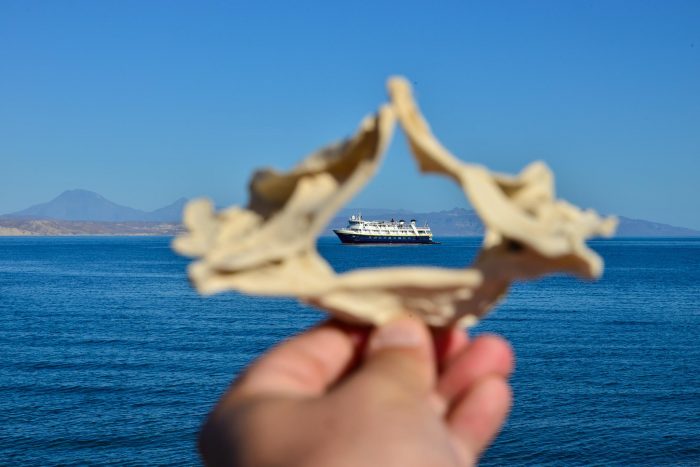
However, things are slowly changing for the better. The people of Baja are increasingly recognizing the value that sustainable tourism and fishing offers the region; legislation is protecting more of the Sea of Cortez, and operators like Lindblad Expeditions-National Geographic are helping shed light on the problems the Gulf of California faces while funding conservation initiatives that can help preserve this underwater wonderland for generations to come.
READ: These Serums Will Protect Your Skin on the Road
As with other Nat Geo-branded cruises, education is as much a part of a Lindblad-Expeditions National Geographic cruise as sightseeing. In addition to insightful lectures and talks held in the ship’s bar, each day we climb into the Sea Bird’s fleet of zodiacs to explore desolately beautiful coastlines and to delve into Baja’s dramatic, desert islands. On Isla Santa Catalina, naturalist David Stephens points out some of Baja’s 110 species of cactus, 70 percent of which are endemic, as we hike up a dry arroyo in search of spiny tail iguanas, pinto chuckwallas, rattleless rattlesnakes, and ancient agave fermentation pits.
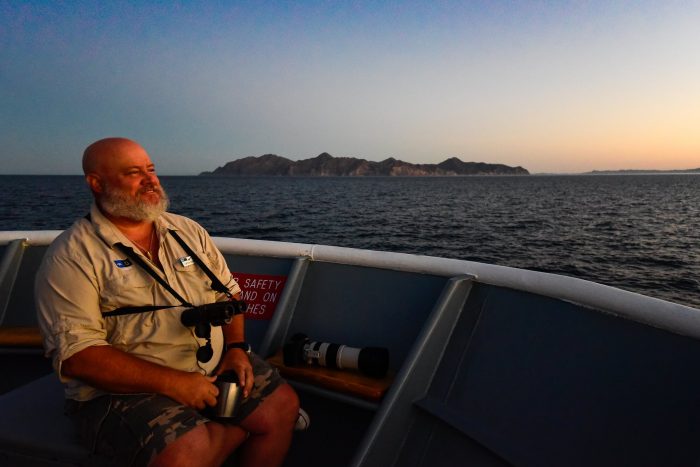
During one of the regular photography walks, I join Nat Geo-certified photo instructor Linda Burback to explore the former mining town of Santa Rosalia, tracing graceful pelicans as they skim across the waters of the harbor and perch in the ruins of the warehouses which once stored ore from the French-owned copper mine. A lazy afternoon exploring Isla San José’s breathtaking coastline ends with a beach barbeque and a lesson from my new American friends on how to prepare the perfect s’mores.
READ: These Are Not Your Average Honeymoon Travel Ideas
A few days later I cruise the protected coastline of tiny San Pedro Mártir Island with naturalist Berit Solstad; here the air is alive with the calls of marine birds, from blue-footed boobies and yellow-footed gulls to eared grebes, graceful frigates, and proud brown pelicans, all of which build their nests on the tiny pumice islet. San Pedro Mártir is home to 95 percent of the world’s population of elegant terns and Hermann’s gulls, the eggs of which were once used in the coveted pan dulce aquí pastries of Santa Rosalia’s El Bolero bakery (below). Following the coastline in our fleet of zodiacs, the air is alive with gossiping, swooping, soaring, darting seabirds. High on a rocky crest, a mating pair of osprey keep a watchful eye on our progress, and, underway again on the Sea Bird, we marvel at a pair of rarely-encountered long-finned pilot whales surfacing briefly before diving deep in search of dinner.

There are opportunities to explore as a group, and chances to grab a paddleboard or kayak and explore at your own speed. At Bahia Bonanza, an elegantly-curving bay of white sand and turquoise water on the island of Los Islotes I join a group of snorkelers guided by Mexican biochemist Carlos Navarro, who has an intimate knowledge of the Sea of Cortez, having studied it for much of his life. At Isla San Marcos, some guests snorkel at a hidden grotto, while others trace a dried riverbed inland, or take to the coast in zodiacs in search of brown footed boobies, pelicans, herons, egrets, and vibrant sally lightfoot crabs, before silently trailing a pair of graceful humpback whales as they meander past the ship.
READ: Explorer Jon Muir is a True Man of the Earth
We finish our adventure on the Sea of Cortez in style, first by greeting the dawn from the zodiacs, capturing the ship through a natural hole in a fang of rock that just from the ocean, and then with a snorkeling expedition with the sea lions of the Espiritu Santo Biosphere Reserve. It’s a truly spectacular experience as the inquisitive, puppy-like sea lions show off, tumbling and swooping through the water, inches from snorkelers, trails of bubbles in their wake, their whiskers dancing in the currents.
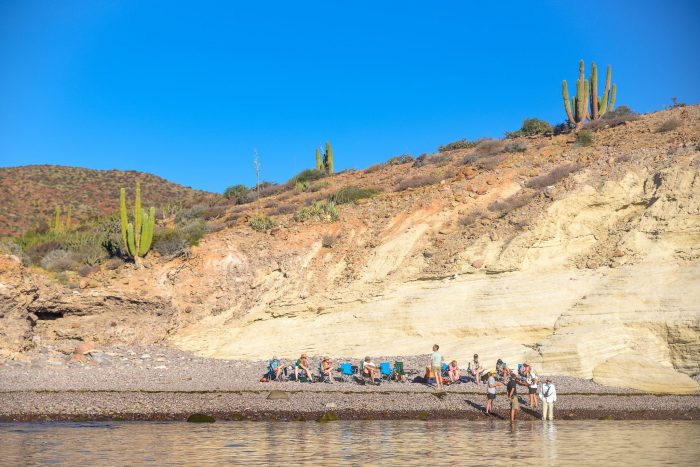
Overfishing may have reduced the number of sharks in the Sea of Cortez, but fortunately, that’s allowed the populations of whales, dolphins, and sea lions to flourish. With a little help and the efforts of companies like Lindblad Expeditions, there’s hope this aquatic wonderland will continue
to thrill travelers for generations to come.
Travel Essentials
Fly: American Airlines, a member of oneworld, links points in Europe, Asia, and North America with Cabo San Lucas via Los
Angeles.
Cruise: Lindblad-Expeditions National Geographic’s eight-day Whales &
Wilderness itinerary is priced from US$6,190 per person twin share, inclusive of meals, accommodation, and excursions, with departures between December and April each year.
For more Cruise adventures click here.

